Water Inrush Hazard in Shijingshan Tunnel during Construction, Zhuhai, Guangdong, China
Abstract
:1. Introduction
2. Background
3. Results
3.1. Water Inrush Accident
- The accident area with complex hydrogeological conditions is a hilly landform, and the main strata are granite and weathered soil. Fractures are developed in local granite. Huwan Fault and Jida fault are found in the surrounding area, which are affected by tunnel construction and flood accident. Affected by the surrounding faults and secondary faults, the fracture development of rock mass in the accident area had reached a state of fragmentation.
- There is a strong hydraulic connection between the tunnel and Jida reservoir. The water level of the reservoir decreased by 1.9 m within 1.5 h since the occurrence of water inrush accident. An estimate of 2.2 × 105 m3 water flowed from the reservoir into the tunnels. Due to the enhanced hydraulic connection in the early stage, abundant water supply in the tunnel increased the difficulty of drainage in the tunnel. At the same time, influenced by tunnel construction and the flooding accident, the hydraulic connection between the Jida reservoir and the tunnel increased, and abundant water supply in the tunnel further increased the difficulty of drainage in the tunnel.
- The construction workers were trapped in the downhill section of the tunnel. The tunnel has a slope of 3%, so is not a straight tunnel. As the trapped personnel point was located in the downhill section, the slope of the tunnel lead to mud and sediment deposition, resulting in frogmen and underwater robots closer to the trapped point. The muddier the water, the more complex the rescue environment.
3.2. Rescue Operation
- In the upstream of the reservoir, a water barrier cofferdam was set to divide the reservoir into two parts, blocking the connection between the subsidence area and the water source of the reservoir, so that the external inflow of water into the tunnel was reduced from the original whole reservoir to a small pond. Then, the existing body of water above the tunnel collapse was drained. Through performing the above measures, the Jida reservoir surface water supply to the cave was prevented. Drainage equipment had been continuously increased, including 10 mud pumps, 7500 kW generators, 175 kW mixed-flow pump, 275 kW water pumps, 330 kW submersible pumps, 390 kW sewage pumps and 10 tank trucks. Pumping was also carried out inside the tunnel (see Figure 3). To solve the problem of excessive carbon monoxide concentration in the tunnel, the rescue team added and started 8 jet fans on the basis of the existing 8 axial flow fans, which improved the rescue operation environment.
- The rock was already broken, so strong grouting was needed during the rescue to ensure the safety of people at the rescue operation surface. After the water was drained, the soil was backfilled in the surface pit, and the mechanical equipment working face was created by leveling and compaction. Figure 4 depicts the rescue site of reservoir above tunnel. Then, the all-in-one machine drilled and fully spread, and the double-liquid grouting technology was adopted to reinforce the backfilled soil and the face of the tunnel. The double slurry can be solidified within 30 to 50 s, so that the backfill soil can be solidified and compacted quickly, subsequently, the original loose soil can be condensed into a compact and integrated structure, so it can effectively block the reservoir water and underground fissure water flowing into the tunnel. Twenty sets of equipment and more than 110 workers had been invested, and the backfilling of the vault was completed by 3 p.m. on 16 July, with around 11,000 square meters of soil. As of 9 a.m. on 17 July, 90 tons of cement and 20 tons of sodium silicate had been put into the site, 12 integrated drilling and injection machines had been put into operation, and 50 square meters of grouting had been completed.
- Guangzhou Salvage Bureau of the Ministry of Transport had the primary goal of sparing no effort to save people, eight south China Sea salvage bureau divers, six Guangzhou salvage bureau divers and three rescue experts rushed to the scene to participate in the emergency rescue. As of 9 a.m. on the 19th, the bureau had sent four batches of divers for a total of 16 h of search and rescue in more than 900 m of tunnel waters. Figure 5 shows the divers launched search and rescue.
- Monitoring the tunnel structure safety and harmful gases in the cave. In order to prevent the occurrence of secondary disasters, the real-time monitoring of surface hydrology was constantly strengthened, especially the monitoring of mountain, reservoir, water body and surface backfill (see Figure 6). They monitored for tunnel leakage, ground subsidence and toxic and harmful gases in the cave and establishing a regular warning mechanism for the inside and outside of the cave every 30 min, to ensure the safety of rescue workers.
4. Discussion
4.1. Geological Condition
4.2. Inrushing Mechanism
4.3. Heavy Rainfalls
5. Reflections
- The development of water inrush is complicated, and it is difficult to acquire a comprehensive understanding on the mechanisms of water inrush. There exist some influencing factors which contribute the occurrence of water inrush, such as, stress change during tunneling, the development of rock fissure, the change of surrounding environment, etc. Due to the coupling effects of these mentioned factors, the traditional empirical methods are not suitable anymore. The artificial intelligent (AI) methods are potential techniques to handle situations where many influencing factors exist coupled together. A combination of geographical information systems (GIS) and AI have the potential ability to reveal the mechanism of water inrush during tunneling.
- It is necessary to have a clear survey on the engineering geology on the path of the tunnel to be constructed. The borehole method is commonly adopted in real practice. However, the construction workers have to balance the cost of drilling boreholes and the accuracy of engineering geology. Then, it is a challenging task to predict the variation of geology conditions based on limited borehole data. It is a good choice to combine the new arising techniques, such as transient electromagnetic technique and ground penetration radar method, with the traditional borehole method to obtain high fidelity prediction of geology conditions.
- It is crucial to establish monitoring systems to mitigate the damage caused by water inrush accidents. Reliable monitoring methods should be cost-effective and user friendly and they are convenient to be applied in complex geological conditions, such as karst geology. Nowadays, the new emerging fiber-based sensors are popular in geotechnical engineering, and they can efficiently measure the stress change, displacement, water pressure, etc. This type of technique is more suitable for tunneling projects that involve a number of influencing factors. Based on the collected data associated with an AI algorithm, the monitoring center can provide instructions or give a warning when the situation becomes irregular.
- The partial application of shield construction can be considered. As a powerful temporary support structure, a shield can resist external water pressure and bottom pressure. The construction of long tunnels, which have a large buried depth in soft water-bearing stratum often have technical and economic advantages and fit the construction conditions of this project.
6. Concluding Remarks
- A catastrophic water inrush accident occurred at a tunnel construction site in Zhuhai City, this accident was located under a reservoir named Jida Reservoir, rendering rescue extremely difficult and resulting in 14 casualties.
- The disaster was triggered by the coupling effects of: (i) high hydraulic conductivity of the surrounding soils at the construction site, (ii) faults formed around the construction site (F69), (iii) heavy rainfall prior to the accident and (iv) water source from the overlying reservoir.
- It is necessary to conduct risk assessments in water inrush hazard-prone areas during tunneling. Effective in situ monitoring methods should be utilized to forecast possible human made disasters. Further, it is significant to investigate the geological condition along the path of tunneling using AI methods based on limited borehole data. An AI technique can assist in monitoring the occurrence of this kind of accident and enhance the rescue efficiency. For instance, AI techniques can monitor the water seepage point and the deformation of the excavation surface in the primary stage, and thus warn the manager for countermeasures. It can also track and identify survivors in the rescue process, which can save lives.
Author Contributions
Funding
Institutional Review Board Statement
Informed Consent Statement
Data Availability Statement
Conflicts of Interest
References
- Lyu, H.M.; Shen, S.L.; Zhou, A.; Chen, K.L. Calculation of pressure on the shallow-buried twin-tunnel in layered strata. Tunn. Undergr. Space Technol. 2020, 103, 103465. [Google Scholar] [CrossRef]
- Lin, S.S.; Shen, S.L.; Zhou, A.; Xu, Y.S. Risk assessment and management of excavation system based on fuzzy set theory and machine learning methods. Autom. Constr. 2021, 122, 103490. [Google Scholar] [CrossRef]
- Lyu, H.M.; Zhou, W.H.; Shen, S.L.; Zhou, A. Inundation risk assessment of metro system using AHP and TFN-AHP in Shenzhen. Sustain. Cities Soc. 2020, 56, 102103. [Google Scholar] [CrossRef]
- Lin, S.S.; Shen, S.L.; Zhou, A.; Xu, Y.S. Novel model for risk identification during karst excavation. Reliab. Eng. Sys. Saf. 2021, 209, 107435. [Google Scholar] [CrossRef]
- Atangana Njock, P.G.; Shen, S.L.; Zhou, A.; Modoni, G. Artificial neural network optimized by differential evolution for predicting diameters of jet grouted columns. J. Rock Mech. Geotech. Eng. 2021, 13, 1500–1512. [Google Scholar] [CrossRef]
- Chin, Y.T.; Chen, J. Foundation pit collapse on 8 June 2019 in Nanning, China: A brief report. Safety 2019, 5, 68. [Google Scholar] [CrossRef] [Green Version]
- Yu, C.; Zhou, A.; Chen, J.; Arulrajah, A.; Horpibulsuk, S. Analysis of a tunnel failure caused by leakage of the shield tail seal system. Undergr. Space 2020, 5, 105–114. [Google Scholar] [CrossRef]
- Shen, S.L.; Wu, H.N.; Cui, Y.J.; Yin, Z.Y. Long-term settlement behavior of metro tunnels in the soft deposits of Shanghai. Tunn. Undergr. Space Technol. 2014, 40, 309–323. [Google Scholar] [CrossRef]
- Chai, J.C.; Shen, S.L.; Ding, W.Q.; Zhu, H.H.; Cater, J.P. Numerical investigation of the failure of a building in Shanghai, China. Comput. Geotech. 2014, 55, 482–493. [Google Scholar] [CrossRef]
- Kardani, N.; Zhou, A.; Nazem, M.; Shen, S.L. Improved prediction of slope stability using a hybrid stacking ensemble method based on finite element analysis and field data. J. Rock Mech. Geotech. Eng. 2021, 13, 188–201. [Google Scholar] [CrossRef]
- Zhang, N.; Zheng, Q.; Elbaz, K.; Xu, Y.S. Water Inrush Hazards in the Chaoyang Tunnel, Guizhou, China: A Preliminary Investigation. Water 2020, 12, 1083. [Google Scholar] [CrossRef]
- Shen, S.L.; Lyu, H.M.; Zhou, A.; Lu, L.H.; Li, G.; Hu, B.B. Automatic control of groundwater balance to combat dewatering during construction of a metro system. Autom. Constr. 2021, 123, 103536. [Google Scholar] [CrossRef]
- Xie, Z.F.; Shen, S.L.; Arulrajah, A.; Horpibulsuk, S. Environmentally sustainable groundwater control during dewatering with barriers: A case study in Shanghai. Undergr. Space 2020, 6, 12–23. [Google Scholar] [CrossRef]
- Lyu, H.M.; Shen, S.L.; Yang, J.; Zhou, A. Risk assessment of earthquake-triggered geohazards surrounding Wenchuan, China. Nat. Hazards Rev. 2020, 21, 05020007. [Google Scholar] [CrossRef]
- Zheng, H.; Wang, L.W. Analysis on the climatic characteristics and impact of Rainstorm in Zhuhai. Guangdong Meteorol. 2020, 36, 19–23. [Google Scholar]
- Zheng, Q.; Lyu, H.M.; Zhou, A.; Shen, S.L. Risk assessment of geohazards along Cheng-Kun railway using fuzzy AHP incorporated into GIS. Geomat. Nat. Hazards Risk 2021, 12, 1508–1531. [Google Scholar] [CrossRef]
- Lyu, H.M.; Shen, S.L.; Zhou, A.; Yang, J. Risk assessment of mega-city infrastructures related to land subsidence using improved trapezoidal FAHP. Sci. Total Environ. 2020, 717, 135310. [Google Scholar] [CrossRef] [PubMed]
- Wu, H.N.; Shen, S.L.; Chen, R.P.; Zhou, A. Three-dimensional numerical modelling on localised leakage in segmental lining of shield tunnels. Comput. Geotech. 2020, 122, 103549. [Google Scholar] [CrossRef]
- Lyu, H.M.; Sun, W.J.; Shen, S.L.; Zhou, A. Risk assessment using a new consulting process in fuzzy AHP. J. Constr. Eng. Manag. 2020, 146, 04019112. [Google Scholar] [CrossRef]
- Elbaz, K.; Shen, S.L.; Zhou, A.; Yin, Z.Y.; Lyu, H.M. Prediction of disc cutter life during shield tunneling with AI via the incorporation of a genetic algorithm into a GMDH-type neural network. Engineering 2021, 7, 238–251. [Google Scholar] [CrossRef]
- Lin, S.S.; Shen, S.L.; Zhou, A.; Xu, Y.S. Approach based on TOPSIS and Monte Carlo simulation methods to evaluate lake eutrophication levels. Water Res. 2020, 187, 116437. [Google Scholar] [CrossRef] [PubMed]
- Yin, Z.Y.; Jin, Y.F.; Shen, J.S.; Hicher, P.Y. Optimization techniques for identifying soil parameters in geotechnical engineering: Comparative study and enhancement. Numer. Anal. Methods Geomech. 2018, 42, 70–94. [Google Scholar] [CrossRef]
- Lyu, H.M.; Shen, S.L.; Zhou, A.N.; Yang, J. Perspectives for flood risk assessment and management for mega-city metro system. Tunn. Undergr. Space Technol. 2019, 84, 31–44. [Google Scholar] [CrossRef]
- Wang, Z.F.; Shen, S.L.; Modoni, G.; Zhou, A. Excess pore water pressure caused by the installation of jet grouting columns in clay. Comput. Geotech. 2020, 125, 103667. [Google Scholar] [CrossRef]
- Shen, S.L.; Wang, Z.F.; Cheng, W.C. Estimation of lateral displacement induced by jet grouting in clayey soils. Geotech. ICE 2017, 67, 621–630. [Google Scholar] [CrossRef]
- Wang, Z.F.; Shen, S.L.; Modoni, G. Enhancing discharge of spoil to mitigate disturbance induced by horizontal jet grouting in clayey soil: Theoretical model and application. Comput. Geotech. 2019, 111, 222–228. [Google Scholar] [CrossRef]
- Yan, T.; Shen, S.L.; Zhou, A.; Lyu, H.M. Construction efficiency during shield tunnelling in soft deposit of Tianjin. Tunn. Undergr. Space Technol. 2021, 112, 103917. [Google Scholar] [CrossRef]
- Shen, S.L.; Atangana Njock, P.G.; Zhou, A.; Lyu, H.M. Dynamic prediction of jet grouted column diameter in soft soil using Bi-LSTM deep learning. Acta Geotech. 2021, 16, 303–315. [Google Scholar] [CrossRef]
- Chen, J.H. Progress of Zhuhai Tunnel Flooding Accident: 14 People Trapped 1160 Meters Away from the Entrance. Available online: https://www.thepaper.cn/newsDetail_forward_13594591 (accessed on 15 July 2021).
- Chai, M.Y. Cofferdam Has Been Used to Block the Permeable Point of the Tunnel Seepage Accident, and the Rescue Is in Progress. Available online: https://www.thepaper.cn/newsDetail_forward_13594373 (accessed on 15 July 2021).
- Li, X.H.; Wang, D. Characteristics of precipitation of Zhuhai since 1962 to 2010. Guangdong Meteorol. 2012, 34, 35–37. [Google Scholar] [CrossRef]
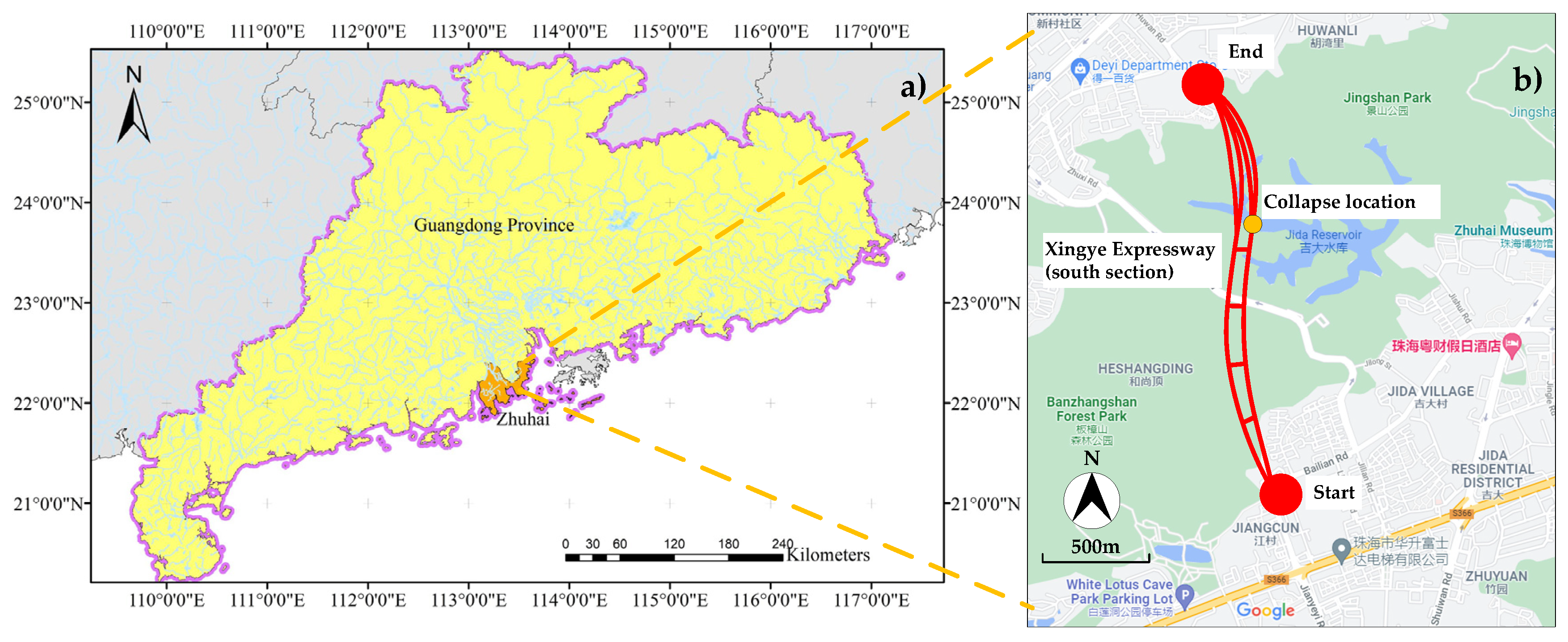
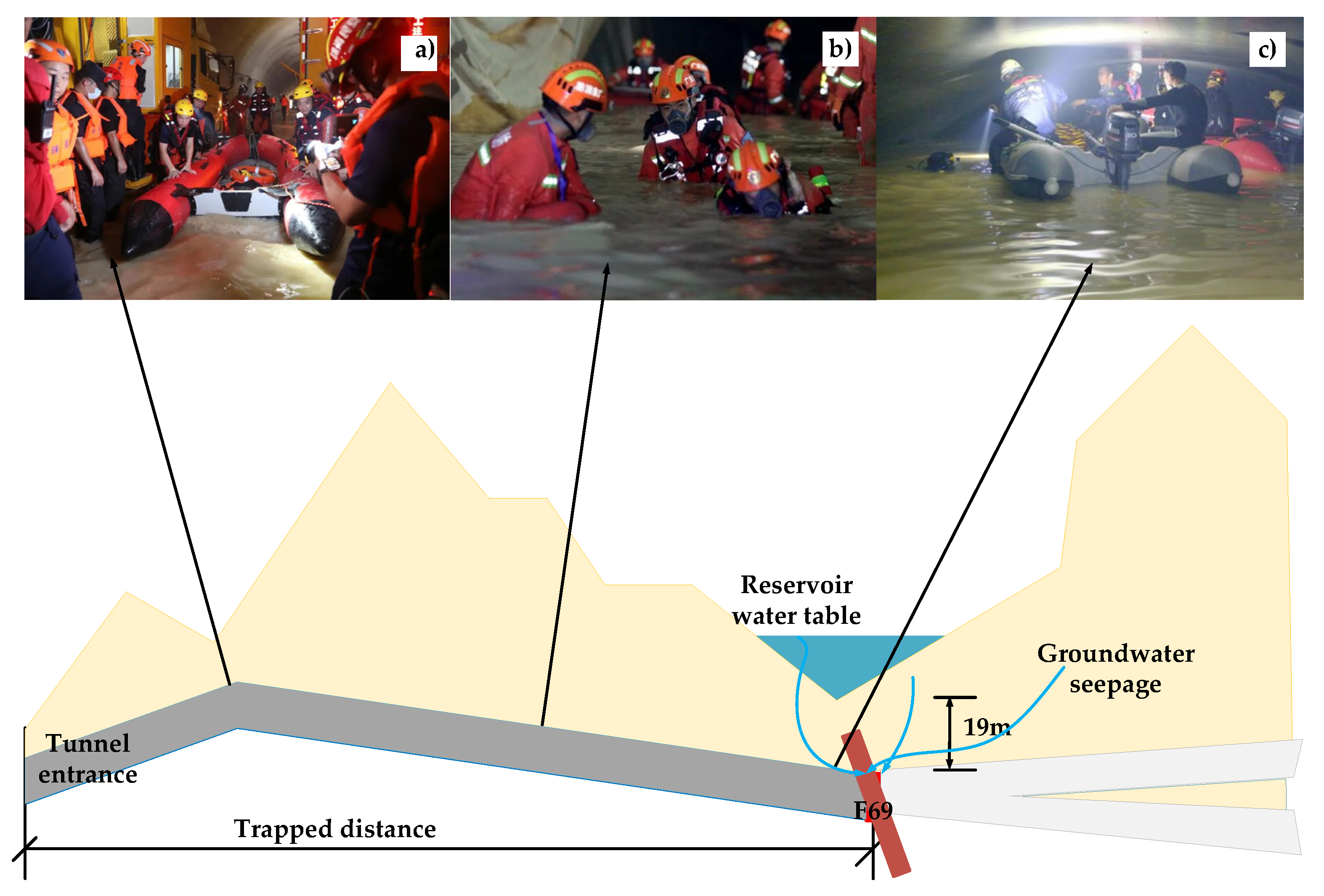
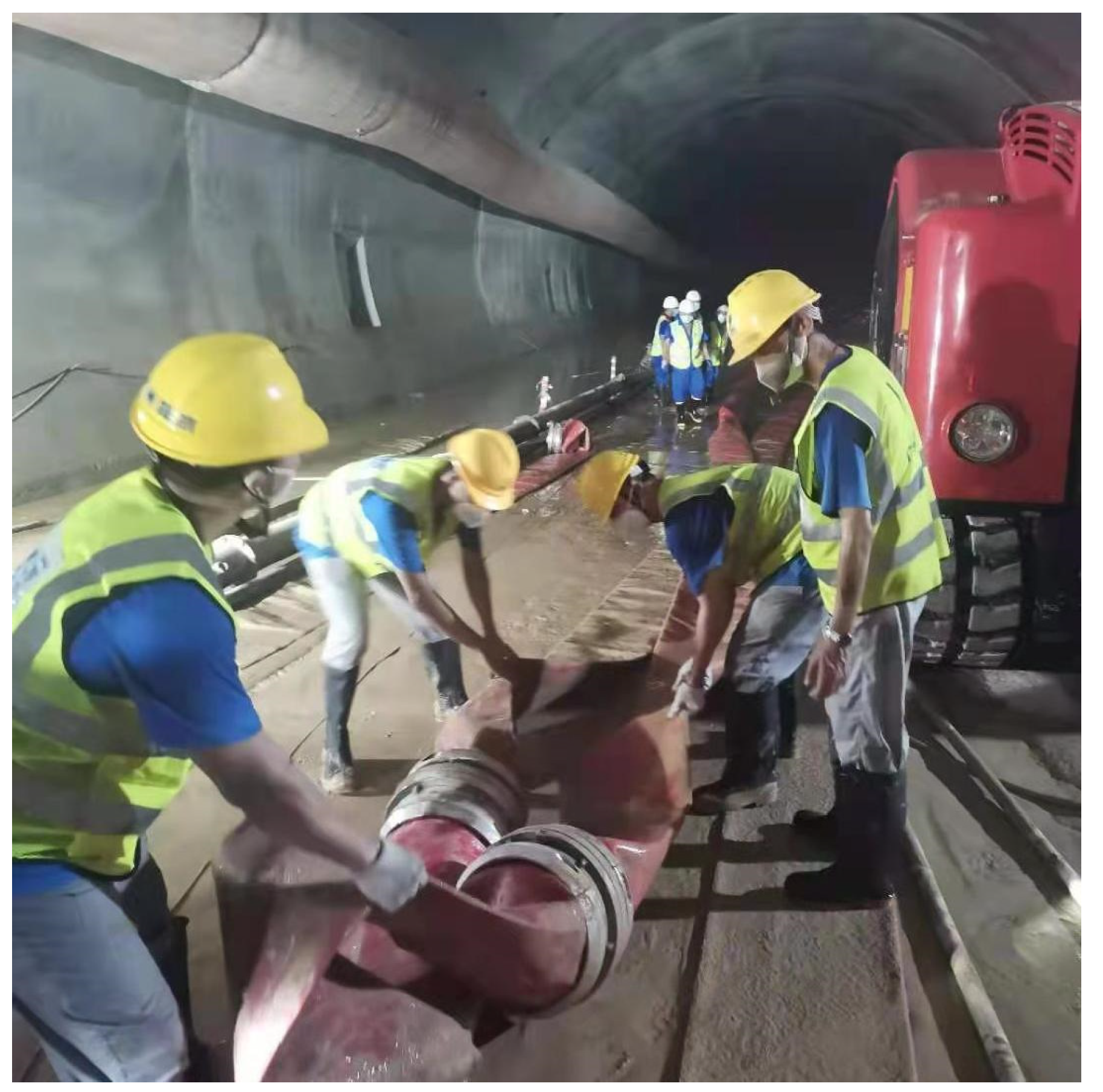
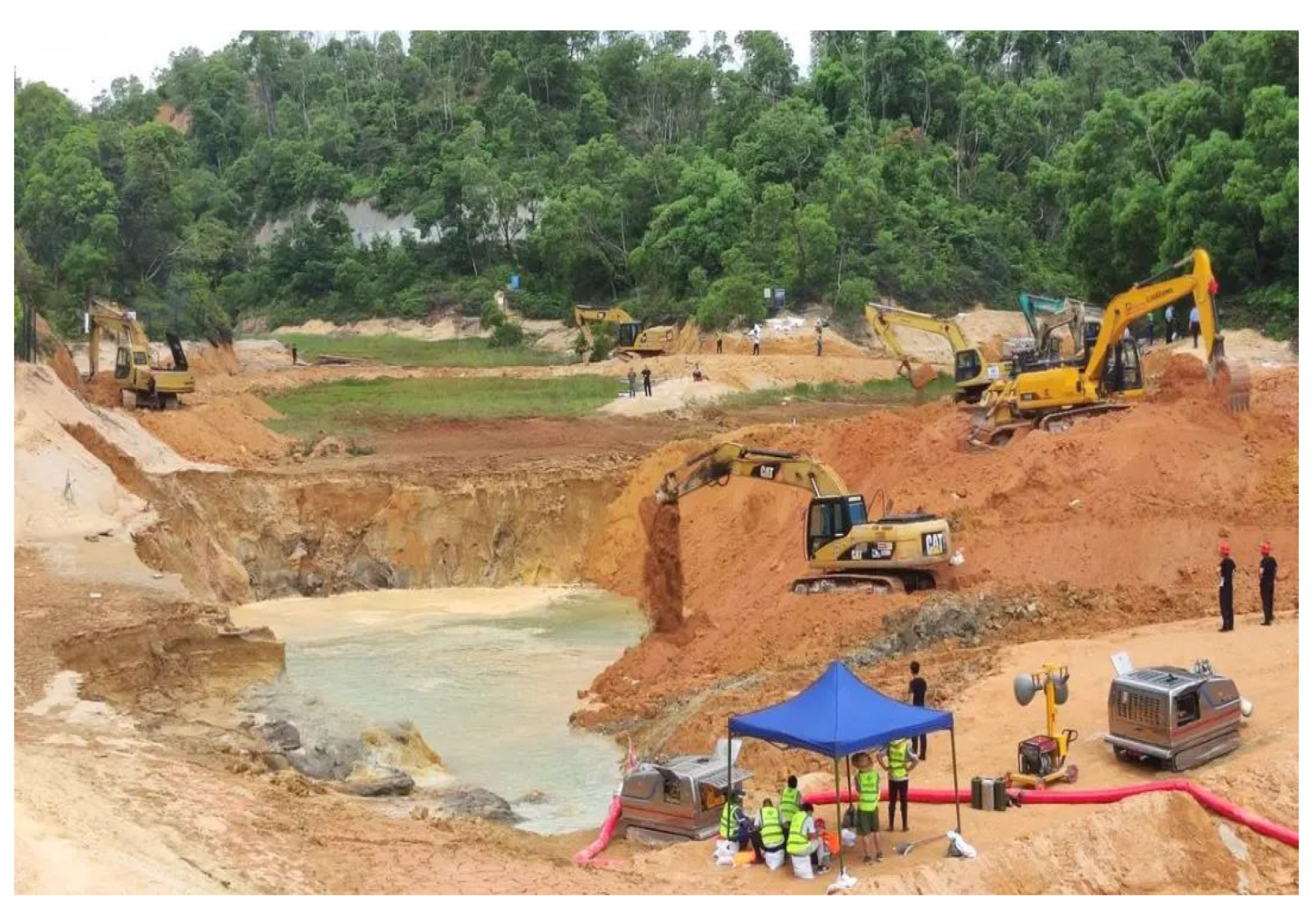
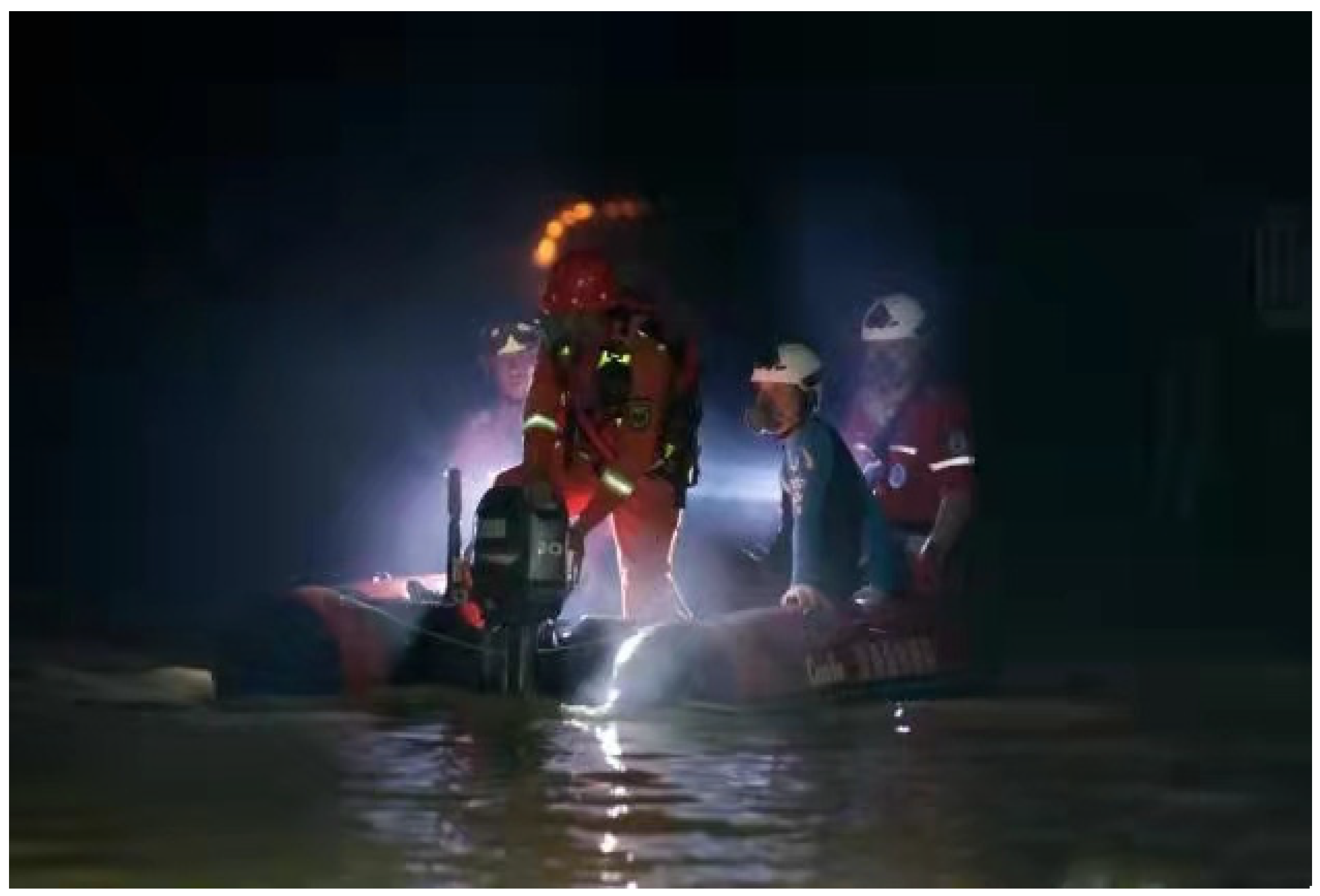
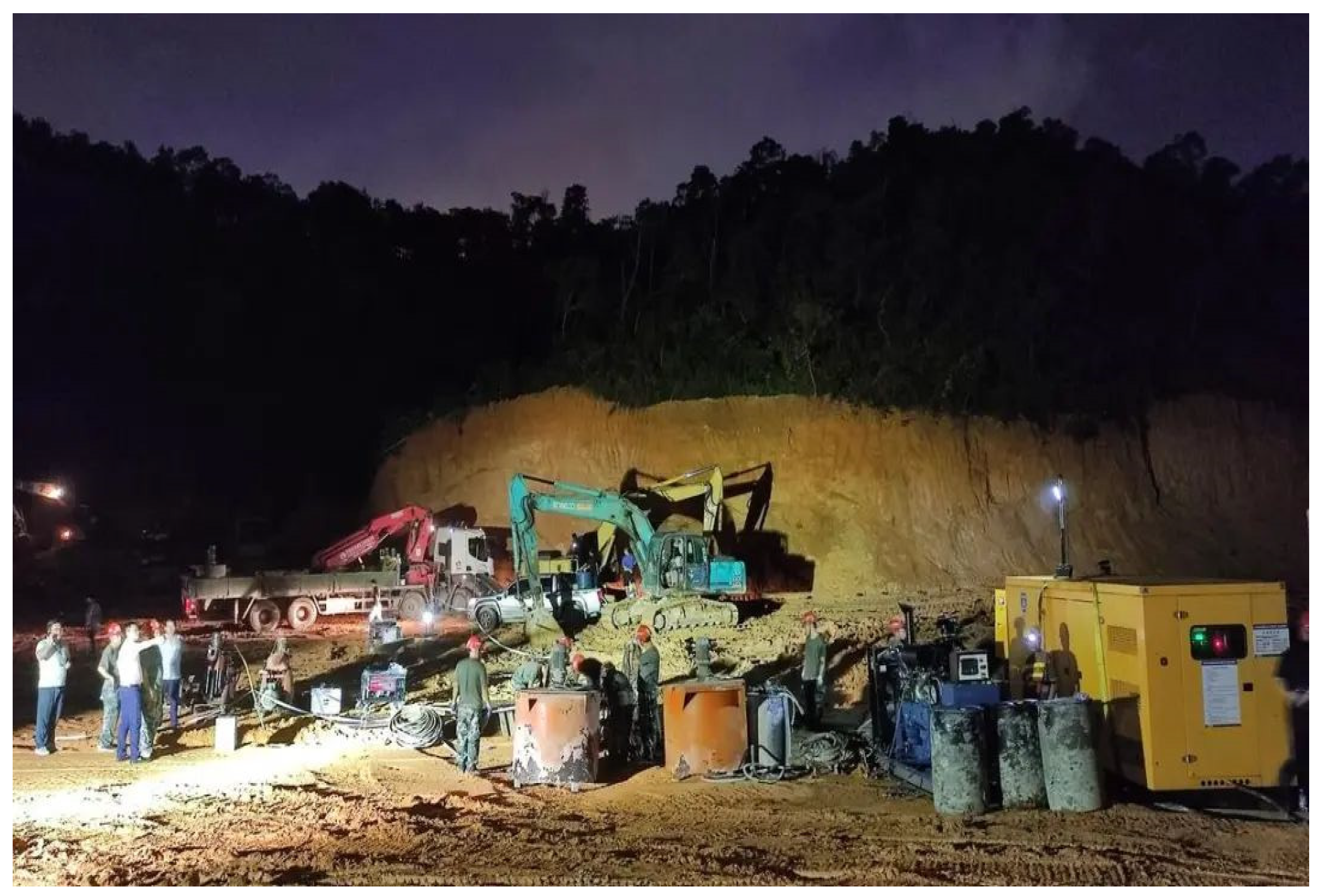


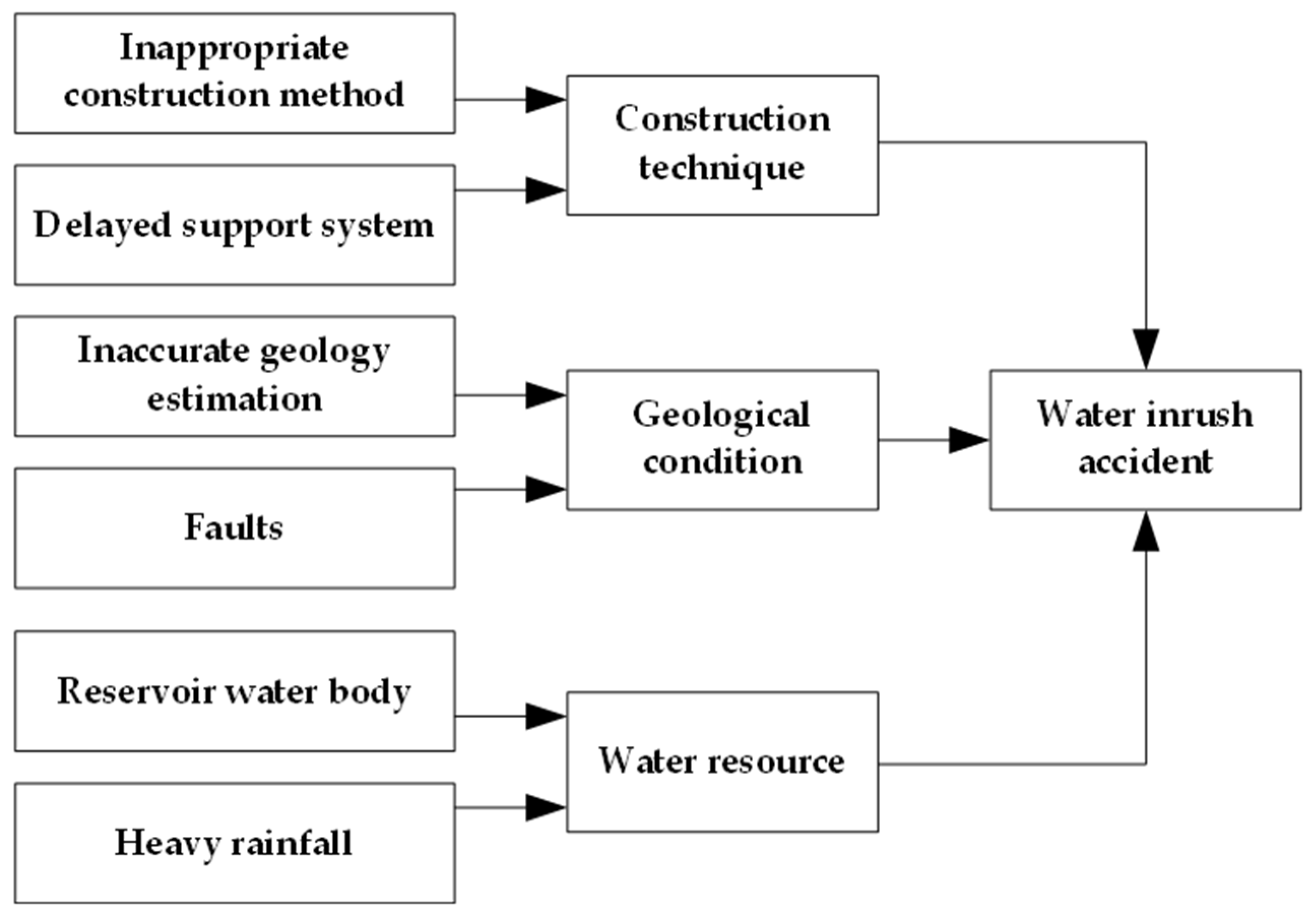
| Type | (kPa) | w (%) | C (kPa) | φ (°) | Es1–2 (MPa) | E0 (MPa) | |
|---|---|---|---|---|---|---|---|
| Fill soil | 90 | 18.3 | 25.0 | 22.0 | 15.1 | 4.15 | |
| Gravel sand | 170 | 18.1 | 12.6 | - | 41.7 | ||
| Fully weathered | 300 | 19.0 | 22.5 | 21.2 | 25.4 | 5.02 | 118.5 |
| Strongly weathered | 600 | - | - | - | - | - | 234.6 |
| Moderately weathered | 1500 | = 24.85 Mpaa | |||||
| Slightly weathered | 2800 | = 49.12 Mpa | |||||
Publisher’s Note: MDPI stays neutral with regard to jurisdictional claims in published maps and institutional affiliations. |
© 2022 by the authors. Licensee MDPI, Basel, Switzerland. This article is an open access article distributed under the terms and conditions of the Creative Commons Attribution (CC BY) license (https://creativecommons.org/licenses/by/4.0/).
Share and Cite
Kong, H.-Q.; Zhao, L.-S.; Zhang, N. Water Inrush Hazard in Shijingshan Tunnel during Construction, Zhuhai, Guangdong, China. Safety 2022, 8, 7. https://doi.org/10.3390/safety8010007
Kong H-Q, Zhao L-S, Zhang N. Water Inrush Hazard in Shijingshan Tunnel during Construction, Zhuhai, Guangdong, China. Safety. 2022; 8(1):7. https://doi.org/10.3390/safety8010007
Chicago/Turabian StyleKong, He-Qi, Lin-Shuang Zhao, and Ning Zhang. 2022. "Water Inrush Hazard in Shijingshan Tunnel during Construction, Zhuhai, Guangdong, China" Safety 8, no. 1: 7. https://doi.org/10.3390/safety8010007
APA StyleKong, H.-Q., Zhao, L.-S., & Zhang, N. (2022). Water Inrush Hazard in Shijingshan Tunnel during Construction, Zhuhai, Guangdong, China. Safety, 8(1), 7. https://doi.org/10.3390/safety8010007






